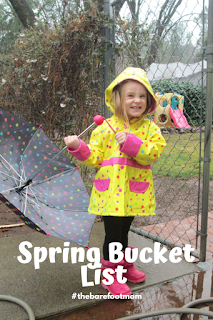Spring is my favorite season. The weather starts getting warm. Everything is in bloom. There's lots of insects and wildlife to observe. It's a beautiful time of year. One of the best things about spring is that my kids can start spending lots of time outdoors again. Outdoors they have space to burn energy and play freely, like kids are meant to do. It also gives them a lot of opportunities to explore and learn about the natural world around them.
This year I decided to put together a bucket list of all the fun outdoor activities I'd like my kids to get an opportunity to do this spring.
Spring Bucket List:
-Go puddle stomping. What kid doesn't love a good puddle to stomp in?
-Search for four leafed clovers. My 8 year old has already found one this spring!
-Fly a kite!
-Explore a field of wildflowers. You could even turn this into a nature study lesson by trying to identify the different flowers you see.
-Catch a tadpole.
-Find a caterpillar.
-Watch a thunderstorm.
-Play in the rain.
-Go fishing.
-Go on a picnic.
-Blow bubbles in the park.
-Plant a garden. We don't have a yard to plant in this year, so we're doing a small herb garden in pots on our apartment balcony instead.
-Go bird watching. This is another one that could easily be made into a school lesson. Bring a bird guide and try to identify the birds you see.
-Build a backyard fort.
-Take a bike ride.
-Go on an egg hunt.
-Feed the ducks at the pond. But remember that bread isn't good for them. Try sliced grapes, old fashioned oats, or unsalted sunflower seeds instead.
-Run barefoot in the grass.
-Go rock hounding. Rock hounding is a term that refers to the amateur hunting and collecting of rocks and minerals.
-Go on lots of nature hikes!
What's on your spring bucket list?
If you enjoyed this post, check out:
-6 Reasons To Let Your Kids Play In The Mud
-4 Reasons To Take Your Kids Fishing
-Rock Hounding With Kids
Follow me on:
Facebook
Instagram
Pinterest
This year I decided to put together a bucket list of all the fun outdoor activities I'd like my kids to get an opportunity to do this spring.
Spring Bucket List:
-Go puddle stomping. What kid doesn't love a good puddle to stomp in?
-Search for four leafed clovers. My 8 year old has already found one this spring!
-Fly a kite!
-Explore a field of wildflowers. You could even turn this into a nature study lesson by trying to identify the different flowers you see.
-Catch a tadpole.
-Find a caterpillar.
-Watch a thunderstorm.
-Play in the rain.
-Go fishing.
-Go on a picnic.
-Blow bubbles in the park.
-Plant a garden. We don't have a yard to plant in this year, so we're doing a small herb garden in pots on our apartment balcony instead.
-Go bird watching. This is another one that could easily be made into a school lesson. Bring a bird guide and try to identify the birds you see.
-Build a backyard fort.
-Take a bike ride.
-Go on an egg hunt.
-Feed the ducks at the pond. But remember that bread isn't good for them. Try sliced grapes, old fashioned oats, or unsalted sunflower seeds instead.
-Run barefoot in the grass.
-Go rock hounding. Rock hounding is a term that refers to the amateur hunting and collecting of rocks and minerals.
-Go on lots of nature hikes!
What's on your spring bucket list?
If you enjoyed this post, check out:
-6 Reasons To Let Your Kids Play In The Mud
-4 Reasons To Take Your Kids Fishing
-Rock Hounding With Kids
Follow me on:






this year we are adding "catch baby goldfish" as our adults have had babies! Too many for our small pond.
ReplyDeleteI have all big kids and we still love watching thunderstorms.
ReplyDeleteEven as an adult, I LOVE watching thunderstorms. They're fascinating!
DeleteGreat list! You know we'll have plenty of hiking on ours and we want to visit our farmers market more often for fresh fruits and veggies. Thanks so much for sharing with us at the Welcome Spring party. Pinned!
ReplyDeleteI want to visit our farmers market more this year too.
Delete